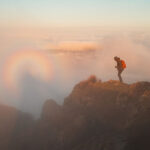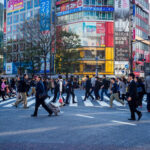
Depth of Field (DOF for short), is usually associated with the aperture which is often used interchangeably with the word f-stop. The Aperture controls the amount of light that passes through the lens and onto the film; or in the digital world, onto the sensor inside the camera. This amount of light is determined by the size of the lens opening (the aperture) inside the lens. On the older traditional 35mm cameras, the settings on the outside of lens that controlled this function were called f-stops. That’s why even though technically they are two different things; many writers use the words aperture and f-stop as if they were one and the same. It’s like calling the door knob, a door. You do use one thing to affect the other, but they are NOT one and the same.
The greater amount of light the aperture allows in, the narrower the depth of field is, and visa versa; the less amount of light the aperture allows inside, the wider the depth of field is. Many beginning students get confused by this. Since the f-stop is what controls this light, the easiest way to remember it is:
Small number = small f-stop (f 1.8) = small amount of picture in focus.
Large number = large f-stop (f 32) = large amount of picture in focus.
The Shutter also affects this same light; where as the aperture controls “how much”, the shutter controls “how long”. If the shot is exposed for too long a time the photograph will appear washed out. If the shot is exposed for too short a time the photograph will appear too dark. This is commonly referred to as: over exposure and under exposure. Shutter Speed (how long things are exposed); can be used to freeze things in midair (with a fast speed), or it can be used to intentionally blur something like water (with a slow speed).

Before your camera can set the correct aperture and shutter speed for any given subject, it needs to know how fast it can collect the light. The speed at which this information is gathered is referred to as the ISO speed. ISO stands for the International Standards Organization; which is the group that created the standard, so that if you got 100 speed films in Germany, England, or Japan they would still all respond the same way.
The general range of ISO speeds in all cameras (digital or otherwise) is from 100 to 1600. The higher the ISO speed the faster the camera collects light, but it also adds more “noise” to the photograph than lower speeds. This “noise” is what older photographers often refer to as how “grainy” a picture is. Most of the time you should use your camera at a lower ISO speed if there is enough light to do so. But for those times that you want to take pictures in dim light without a tripod or flash you can raise your ISO speed so your pictures are not blurry.
Wherever you focus your lens within a given image, there will be an area that is in focus and other areas that are out of focus. The area that is “in focus” is referred to as the “focal plane”. The important thing to remember is that 1/3rd of this focal plane is in front of whatever you focused on, and 2/3rd’s of the focal plane is behind whatever you focused on. By deliberately focusing 1/3rd of the way into your landscape shot and using a high number f-stop (like f-16 or f-22) you capture the greatest amount of the photograph in sharp focus.

If you always trust your camera meter and use what it tells you, you are using what we what refer to as a standard exposure value. Exposure Values are those numbers that refer to the combinations of f-stops and shutter speeds that can give you an accurate exposure under a given light situation. Keep in mind that your meter is a moron! Meters do not see in color, in order to make up for this it will average your scene, and give you a reading for 18% grey. All meters do this it’s not their fault, that’s how they were designed. But what happens if you actually want a white wedding dress to look white? Or what happens if you want that great black stallion to actually look black? That’s where bracketing comes into play.
Most digital cameras and traditional 35mm cameras will allow you to compensate or adjust the cameras meter reading by 1 or 2 EV’s. Since most people do bracketing by adjusting the f-stops this will also effect your depth of field as well as your over all exposure. If your moron, I mean your meter tells you the perfect exposure is f-5.6 @ 1/250th of a second that will give you an average reading for 18% grey. If you want your subject to look brighter than just average, you would shoot at say f2.8 @ 1/250th of a second. If you want your subject to look darker than average you would probably shoot at f-8 @1/250th of a second.

The more you know, the more you grow. Using these controls to enhance Depth of Field in your pictures will help take you to the next level. Not all cameras will allow you to change all these features, but if you explore your manual and find out what you can control . . . you become the master. A great photographer uses his or her camera as a creative tool. Those who only take snap shots let the meter (who is a moron) do all the work for them.
About the Author:
Award winning writer / photographer Tedric Garrison has 30 years experience in photography (better-photo-tips.blogspot.com). As a Graphic Art Major, he has a unique perspective. His photo eBook “Your Creative Edge” proves creativity can be taught. Today, he shares his wealth of knowledge with the world through his website.
Like This Article?
Don't Miss The Next One!
Join over 100,000 photographers of all experience levels who receive our free photography tips and articles to stay current:






Leave a Reply